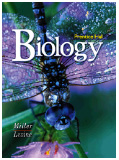BIOLOGY
by Miller & Levine
[complete Table of Contents]

|
Use the pull-down menu to jump to any of the Book's 40 Chapters: |
Additional Resources:
Fact Sheet from the American Association of Blood Banks.
Details of the ABO Blood Groups.
Both of the above resources are helpful in "predicting the success of Blood Transfusions," an Analyzing Data feature on page 954 of the Dragonfly Book.
|
Teaching Resource: A Do-It-Yourself Lung Model (from the University of Arizona). This activity comes with detailed plans using easy-to-find materials. A perfect way for students to understand how contractions of the diaphragm muscle help to fill the lungs. |
![]() Chapter 37
Chapter 37 ![]()
CIRCULATORY
AND RESPIRATORY SYSTEMS
In this chapter, students will read about the structure and function of the circulatory and respiratory systems of the human body. The links below lead to additional resources to help you with this chapter. These include Hot Links to Web sites related to the topics in this chapter, the Take It to the Net activities referred to in your textbook, a Self-Test you can use to test your knowledge of this chapter, and Teaching Links that instructors may find useful for their students.
| Hot Links | |
| Take it to the Net | Teaching Links |
What are Web Codes? |
Web
Codes for Chapter 37: |
![]()
Section 37-1:
The Circulatory System
![]() The human circulatory
system consists of the heart, a series of blood vessels, and the blood
that flows through them.
The human circulatory
system consists of the heart, a series of blood vessels, and the blood
that flows through them.
![]() As the blood flows
through the circulatory system, it moves through three types of blood
vessels—arteries, capillaries, and veins.
As the blood flows
through the circulatory system, it moves through three types of blood
vessels—arteries, capillaries, and veins.
Section 37-2: Blood
and the Lymphatic System
![]() Red blood cells
transport oxygen.
Red blood cells
transport oxygen.
![]() White blood cells
attack foreign substances or organisms.
White blood cells
attack foreign substances or organisms.
![]() Blood clotting
is made possible by plasma proteins and cell fragments called platelets.
Blood clotting
is made possible by plasma proteins and cell fragments called platelets.
![]() A network of vessels
called the lymphatic system collects the fluid that is lost by the blood
and returns it to the circulatory system.
A network of vessels
called the lymphatic system collects the fluid that is lost by the blood
and returns it to the circulatory system.
Section 37-3: The
Respiratory System
![]() The respiratory
system consists of the nose, pharynx, larynx, trachea, bronchi, and lungs.
The respiratory
system consists of the nose, pharynx, larynx, trachea, bronchi, and lungs.
![]() Smoking can cause
such respiratory diseases as chronic bronchitis, emphysema, and lung cancer.
Smoking can cause
such respiratory diseases as chronic bronchitis, emphysema, and lung cancer.
|
